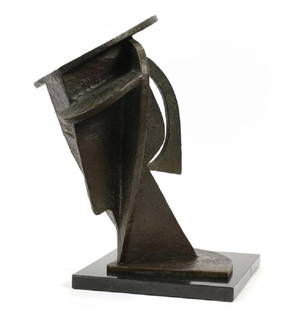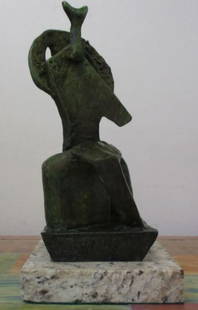

 Weekly: JewelryBonhamsSponsored.Your ad here?
Weekly: JewelryBonhamsSponsored.Your ad here?





 DesignChristie'sSponsored.Your ad here?
DesignChristie'sSponsored.Your ad here?





 DesignChristie'sSponsored.Your ad here?
DesignChristie'sSponsored.Your ad here?




Alexander Archipenko (American/Ukrainian, 1887-1964) - Walking Woman
Alexander Archipenko Sale History
View Price Results for Alexander Archipenko
Related Sculptures & Carvings
More Items from Alexander Archipenko
View MoreRecommended Art
View More









Item Details
Description
Incised ‘Archipenko’ bottom front, polychrome terracotta
Height: 25 3/4 in. (65.4cm)
Width: 8 1/2 in. (21.6cm)
Dppth: 8 in. (20.3cm)
Executed in 1937.
Provenance
Cranbrook Academy of Art, Bloomfield Hills, Michigan.
Parke-Bernet Galleries, New York, sale of March 1, 1972, lot 20.
Perls Galleries, New York, New York, no. 13374.
Sotheby's, New York, sale of May 10, 1995, lot 428.
The Collection of Sidney Rothberg, Philadelphia, Pennsylvania.
Exhibition
“Archipenko,” Stendahl Gallery, Los Angeles, California and Katherine Kuh Gallery, Chicago, Illinois, 1937-1938.
“Exhibition of American Sculpture,” Carnegie Institute, Pittsburgh, Pennsylvania, 1938, cat. no. 93.
“Sculpture by Archipenko,” William Rockhill Nelson Gallery of Art, Kansas City, Missouri, 1938.
"Alexander Archipenko in Retrospection: Drawings, Paintings, Sculpture," University of Omaha, Nebraska and traveling to Philadelphia Art Alliance Gallery, Philadelphia, Pennsylvania; Springfield Museum of Fine Arts, Springfield, Massachusetts, 1939-40.
"Forty Years of Inventive Sculpture by Archipenko," Associated American Artists, New York, New York, 1948, cat. no. 12.
"Original Drawings and Sculpture of Alexander Archipenko," Witte Memorial Museum, San Antonio, Texas; Memphis Brooks Museum of Art, Memphis, Tennessee; Museum of Fine Arts, Houston, Texas, 1950.
“Third Biennial Exhibition of Textiles and Ceramics,” Cranbrook Art Museum, Bloomfield Hills, Michigan, 1951, cat. no. 100 (illustrated).
“An Exhibition of Contemporary Silverwork and Ceramic Sculpture at the Wisconsin Memorial Union Gallery,” Wisconsin Memorial Union Gallery, Madison, Wisconsin, 1953, cat. no. 5.
"Archipenko 110th Exhibition, 50 Years Production," Associated American Artists Galleries, New York, New York, 1954, cat. no. 79.
"200 Years of American Sculpture," Whitney Museum of American Art, New York, New York, 1976, cat. no. 5 (illustrated).
“Archipenko,” Contemporary Sculpture Center, Tokyo, Japan and traveling, 1977, cat. no. 11 (illustrated).
“Alexander Archipenko: A Centennial Tribute 1986-1987,” National Gallery of Art, Washington, D.C. and traveling, p. 180, cat. no. 36 (illustrated).
[Exhibition Title Unknown], Perls Galleries, New York, New York, 1988.
Literature
Alexander Archipenko, “Archipenko: Space, Light, Transparency,” Arts and Architecture, July 1951, p. 26, 46, plate no. 2.
Alexander Archipenko, Archipenko: Fifty Creative Years 1908-1958, Tekhne, New York, 1960, plate no. 162.
Anette Barth, Alexander Archipenko's Plastisches Oeuvre, Teile I und II, Peter Lang, Frankfurt, 1997. [Doctoral diss., University of Trier, Germany], p. 436, 437, cat no. 252.
Frances Archipenko Gray, Alexander Archipenko Catalogue Raisonné, online, no. S.37-03.
Lot Essay
Alexander Archipenko’s earliest model of a walking figure (Walking, s.12-08A, Archipenko online Catalogue Raisonné) was created circa 1912-1918. It was first made in terracotta, the medium Archipenko chose for the present, unique work. While Walking exemplifies the artist’s interest in what he called “the space encircled”–that is, where traditionally “space was understood as a kind of frame around the mass”–Archipenko consciously countered that tradition by implementing the opposite idea, saying: “Traditionally there was a belief that sculpture begins where material touches space...Ignoring this tradition, I experimented, using the reverse idea and concluded that sculpture may begin where space is encircled by the material.” Succinctly stated, from early on, Archipenko pioneered avant-garde ideas about negative space in three-dimensional works; he replaced solid shapes with voids and thus successfully blended Cubist principles with a keen interest in space and movement.
By 1937, when Archipenko executed Walking Woman, his work was labelled as ‘Degenerate Art’ by the Nazis, and was subsequently confiscated, putting him in the company of a long list of pioneering modern artists whose work was to meet the same fate. That same year, Archipenko lived in Chicago, where he was invited to teach at the New Bauhaus Chicago as head of Modelling Workshop by Laszlo Moholy-Nagy. The multi-talented Hungarian-born artist said of Archipenko, “The credit for the first conscious use of concaves in sculpture–to replace saliences–is due to Archipenko...His attempt leads the observer, by its evident deviation from the customary naturalistic treatment, to a realization of the elementary possibilities of the positive-negative relations.”
As with the present work, it was during this decade that Archipenko also turned to terracotta as a viable medium for his sculpture. Terracotta proved to be both less costly, and had by that time, been widely used, and it became–in addition to bronze and marble–a material the artist was able to very effectively use in capturing the female form.
In the present work, Archipenko depicts a perceptibly confident, striding woman, her right leg and left arm extending forward, with her left leg on a straight angle nearly directly behind her. It is worth noting that for Walking Woman directly relates to a number of similar models of women the artist created during this decade in which the void or negative space–a distinctive feature of so much of the artist’s work–has largely been replaced by the more traditional notion of mass conveying form. Indeed, only a very thin, angular open space is seen in the present work, just to the left of the figure’s left and right legs, and Archipenko pays far greater attention to surfaces. Much of the figure is characterized by a rough or bumpy patina which contrasts sharply with the figure’s highly polished skin, and each of these surfaces is in turn presented with a markedly different hue. The resulting highly stylized walking female figure directly relates to other such Archipenko terracotta sculptures of the period, including Arabian, Josephine Bonaparte, Yellow and Black, and most notably, Woman in Fur.
Buyer's Premium
- 32% up to $1,000,000.00
- 26% up to $4,000,000.00
- 20% above $4,000,000.00
Alexander Archipenko (American/Ukrainian, 1887-1964) - Walking Woman
Shipping & Pickup Options
Item located in Philadelphia, PA, usPayment

Auction Curated By
















![A. ARCHIPENKO: Kneeling Woman - Bronze: Modernist bronze sculpture of a kneeling woman, a later casting, on a base, by Alexander Archipenko (Russian/Ukrainian, 1887 --1964). [Overall: 13" H x 5" W x 5" D].](https://p1.liveauctioneers.com/1221/200323/101328328_1_x.jpg?height=310&quality=70&version=1618006037)































![Emilio Grau-Sala "Sur la Plage" Oil on Canvas: Emilio Grau-Sala (Spanish, 1911-1975), "Sur la Plage" [On The Beach], Oil on Canvas, 1958, signed "Grau Sala" lower right, signed, inscribed "Trouville", dated, and titled to verso. Image: 21.5" H x 2](https://p1.liveauctioneers.com/5649/328023/176731071_1_x.jpg?height=310&quality=70&version=1714409606)













